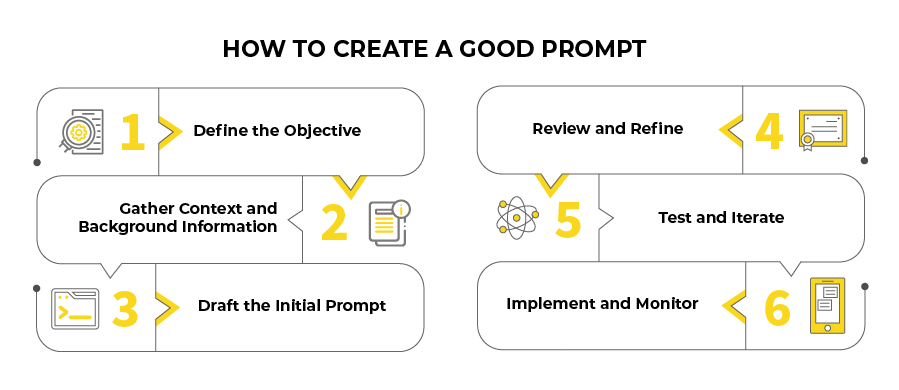Mastering Prompt Engineering for Optimal Results
Discover the Art of Crafting Effective Prompts to Harness the Full Potential of AI
10 Haziran 2024 , Blog
Not all AI is the same; it really depends on the user. So, how does it differ even if we're using the same AI? Since the popularization of ChatGPT and other generative AI tools, everyone can tap into the potential of artificial intelligence—as long as they write good instructions.
As AI becomes more accessible, we're seeing new skills emerge, especially the ability to master prompts. These seemingly simple instructions are the key to unlocking the full potential of AI. But what exactly are prompts? How can we use them effectively? And most importantly, how do we write good prompts? In this article, we'll dive into all of these questions.
AI significantly streamlines operations—there’s no doubt about that. But how do we harness AI's power? The answer lies in prompt engineering. It's already crucial and will become even more important as we strive to use AI more effectively. Essentially, you get out what you put in: if you craft your prompts well, you get the best results from AI. But what exactly are prompts and prompt engineering?
Let's delve deeper into prompts and explore the stages of creating effective prompts to maximize the potential of AI.
What Are Prompts and How to Use Them?
What is a Prompt?
A prompt is simply an instruction given to a generative artificial intelligence. This means AI that can create content, whether it's text, images, or even music. Using its understanding of natural language, the AI algorithm analyzes all of your instructions to respond accordingly.
In other words, it's like giving an order to a machine to execute what you ask.
**Good to know:** Today, prompts are mainly in written form. However, you can also use voice prompts, which have been available for several years through virtual assistants like Alexa or Siri. By speaking your request into your phone or device, your assistant will respond to your command.
What is Prompt Engineering?
Prompt engineering is the process of designing and refining prompts to get the best possible output from AI language models. By giving clear and specific instructions, you can steer the AI to generate relevant and accurate responses that fit your business needs. In this section, we’ll walk you through a structured approach to creating effective prompts that align with your business objectives.
How to Create a Good Prompt?
Generative AI tools offer endless possibilities, but to truly unlock their potential, you need to give them good instructions. This is where mastering prompts becomes essential.
Here's how to craft effective prompts:
Stage 1: Define the Objective
The first step in prompt engineering is to clearly define the objective. What specific goal do you want to achieve with the prompt? Identifying the purpose is crucial as it sets the direction for the entire process.
1. Identify the Purpose: Start by determining the specific goal you want to achieve with the prompt. This could range from increasing customer engagement on social media, generating leads, improving customer support efficiency, to creating compelling marketing content.
Example: If your goal is to increase customer engagement on social media, your prompt should focus on creating engaging and shareable content.
2. Audience Identification: Define who the prompt is for. Understanding your audience is essential as it influences the tone, complexity, and content of the prompt.
Example: A prompt aimed at customers might focus on simplicity and engagement, whereas a prompt for employees might be more detailed and instructional.
Stage 2: Gather Context and Background Information
Once the objective is clear, gather all necessary details and context that the model needs to generate a relevant response. Providing adequate context ensures that the AI understands the environment and requirements accurately.
1. Collect Relevant Information: Gather all the relevant details related to the prompt. This might include product details, recent updates, company policies, or specific scenarios.
Example: For a customer support prompt, you might need information about common issues, product specifications, and troubleshooting steps.
2. Understand the Environment: Consider the platform or medium where the prompt will be used. Different platforms may require different levels of detail or formatting.
Example: A prompt for a chatbot might need to be concise and interactive, while an email prompt might allow for more detailed explanations.
Stage 3: Draft the Initial Prompt
With the objective and context in mind, draft the initial prompt. Craft a clear and specific prompt that guides the AI towards the desired output.
1. Be Clear and Specific: Write the prompt clearly and concisely, specifying the exact output you need. Avoid ambiguity to ensure the AI understands your requirements.
Example: Instead of "Write a report," use "Write a monthly sales performance report, including key metrics such as revenue, units sold, and growth rate."
2. Provide Instructions and Constraints: Include any specific instructions or limitations to guide the response. This helps the AI stay focused and relevant.
Example: "Write a professional email to customers, informing them about the upcoming maintenance schedule. Limit to 150 words."
Stage 4: Review and Refine
After drafting the initial prompt, review it to ensure it meets your objectives and is as clear and specific as possible. Seek feedback and make the necessary revisions.
1. Evaluate Initial Draft: Assess the prompt for clarity, relevance, and alignment with the objective. Ensure it is understandable and provides enough detail.
Example: Check if the prompt clearly states the desired outcome and provides all necessary context.
2. Seek Feedback: Get feedback from relevant stakeholders or team members to ensure the prompt is effective. Different perspectives can help identify areas for improvement.
Example: Share the prompt with your customer support team to ensure it covers all necessary aspects of a typical customer query.
2. Revise for Improvement: Make necessary adjustments based on the feedback and your evaluation. Refine the prompt to improve clarity and specificity.
Example: If the initial prompt was too vague, add more detail or break it down into simpler steps.
Stage 5: Test and Iterate
Testing the prompt with the language model and analyzing the outputs is crucial to ensure it works as intended. Run the tests and evaluate the responses.
1. Run Tests: Use the prompt with the language model to generate responses. This will help you see how the AI interprets and executes the prompt.
Example: Use the prompt in a simulated customer support interaction to see how well it addresses common queries.
2. Analyze Outputs: Evaluate the responses to see if they meet your expectations and objectives. Look for accuracy, relevance, and usefulness.
Example: Check if the responses are accurate, helpful, and match the tone and style you intended.
2. Refine Prompt: Adjust the prompt based on the output analysis to better achieve the desired results. Iterative refinement helps improve the prompt’s effectiveness over time.
Example: If the responses are too general, refine the prompt to include more specific instructions or context.
Stage 6: Implement and Monitor
Once you are satisfied with the prompt, implement it in the intended environment or application. Monitor its performance and make further improvements if necessary.
1. Deploy Prompt: Implement the refined prompt in the live environment, whether it’s a chatbot, email system, or social media platform.
Example: Deploy the prompt in your customer support chatbot and monitor its interactions with customers.
2. Monitor Performance: Track the performance and effectiveness of the prompt in achieving the set objectives. Use metrics and feedback to gauge success.
Example: Measure customer satisfaction, response times, and engagement rates to assess the prompt’s impact.
How CloudOffix Enhances Prompt Engineering
CloudOffix provides a powerful infrastructure that makes your AI limitless, supporting effective prompt engineering for top-quality AI interactions. By centralizing data across various modules, CloudOffix ensures that all necessary information is easily accessible. This comprehensive data collection leads to more informed and context-rich prompts, resulting in accurate and relevant AI outputs. With advanced AI algorithms that are constantly updated, CloudOffix enhances the AI's ability to understand and process complex prompts for high-quality results.
The low-code platform of CloudOffix simplifies creating and refining prompts. Its intuitive tools and user-friendly interface allow users to design and test prompts without needing deep technical knowledge, encouraging more engagement in prompt engineering. Robust security and data protection ensure that all data used for training and processing is securely stored and managed, with strong encryption, access controls, and compliance with industry standards. Continuous monitoring and feedback mechanisms allow for iterative refinement of prompts and improvement of AI interactions, ensuring consistently high-quality responses.
Experience AI without limits. Contact us to book your meeting and learn more.
